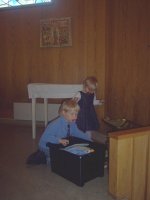
(Click here for a jigsaw puzzle of our church)

(Click here for a jigsaw puzzle of our church)
Sta. Sunniva Church is the parish church for appr. 330 Catholics in Molde and the surrounding municipalities. The parish was established in 1933, the first chapel in the town predates it with 10 years. The church building is from 1957, erected after a generous donation of a lot where the church could be built. It seats appr. 80 people. If you read Norwegian, you can read more about our story if you follow this link (it opens in a new window).
Our patron saint is Saint Sunniva, an Irish princess who, according to her legend, was martyred with her followers at Selja, a bit further South on the coast. (Want to read more? Go to http://www.catholic-forum.com/saints/saints62.htm)
The parishioners are a wide mix of people with different ethnic and cultural backgrounds, as is so common in the Church in Norway. The Filipino members make up a large part of our community, and we are fortunate enough to have a small community of religious sisters with us, who came to Molde from the Phillippines and founded their convent for the Missionary Servants of the Holy Trinity in Molde in 1999.
 |
The carved statue of the Blessed Virgin Mary and the baby Jesus is located just to the right of the Sanctuary (looking towards it). I find it very beautiful. Also the votive candle stand and the baptismal font (which is brought forward when there's a baptism). The stained glass windows show (a) the Victorious Lamb and (b) Grapes, symbolic for the Eucharist.
Click picture for a larger image, which will open in a new window. |
 |
Mikael Johannes and Saga Elisabeth lighting their candles after Mass.
Click picture for a larger image, which will open in a new window. |

|
The altar is located to the North. It is a quite plain altar (very bare in this picture, as the picture is taken after Mass). The tabernacle is located to the right, and the wooden Crucifix in the back.
Click picture for a larger image, which will open in a new window. |
 |
To the left (when looking towards the Altar) is the lectern and in the back a carved wooden statue of St Joseph the worker. Isn't it a lovely statue? This picture was taken on the feast of St. Lorenzo Ruiz, the first canonized martyr of the Phillippines, hence the liturgical colour of red. The stained glass windows show (a)a sheaf of wheat - again pointing towards the Eucharist (the precious Body of our Lord mysteriously present in the form of bread), and (b) a fish and a basket of bread - reminding us of the miracle when Jesus fed several thousand people with only a few fish and a little bread, but also (and more importantly, I think) of the sign through which some of the disciples recognized Jesus after his resurrection, by the Sea of Tiberias(John 21).
Click picture for a larger image, which will open in a new window. |

|
In the back of the church, there's a treasure chest with books, colour-in biblical pictures and toys (mostly cuddly) for the children. (My two kids drag out the lot if they are left to it.) If you look at where Saga's hand points towards the wall, you can see a hinge - it is actually the door leading to the gallery where the organ is located. It hasn't been played during Mass (regularly) since 1990 or so, when the Carolus Borromeus sisters left the town; Sr. Hilde was the only one who could play the thing right. I have tried - and after the first Sunday, Father kindly suggested I play the piano instead... The picture on the wall is a St Olav motif.
Click picture for a larger image, which will open in a new window. |
Stine Cecilia Nerland Lövström (C) 2004